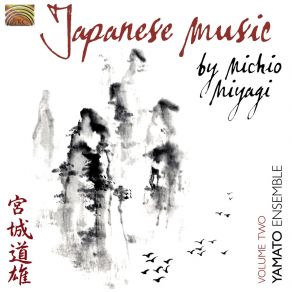Japanese Music by Michio Miyagi, Vol. 2
Download links and information about Japanese Music by Michio Miyagi, Vol. 2 by Yamato Ensemble. This album was released in 2007 and it belongs to Japanoise, World Music genres. It contains 6 tracks with total duration of 01:02:08 minutes.

|
|
|---|---|
| Artist: | Yamato Ensemble |
| Release date: | 2007 |
| Genre: | Japanoise, World Music |
| Tracks: | 6 |
| Duration: | 01:02:08 |
| Buy it NOW at: | |
| Buy on iTunes $9.99 | |
| Buy on iTunes $9.99 | |
Tracks
[Edit]| No. | Title | Length |
|---|---|---|
| 1. | Aki No Shirabe (Autumn Melody) | 12:20 |
| 2. | Isuzugawa (The Holy River of Isuzu) | 11:16 |
| 3. | Mushi No Musashino (Insects of Musashino) | 15:55 |
| 4. | Rondon No Yoru No Ame (A Wet Night in London) | 4:51 |
| 5. | Sekire (The Wagtail) | 2:35 |
| 6. | Mizu No Hentai (All Kinds of Water) | 15:11 |
Details
[Edit]After one successful album of Michio Miyagi's music, ARC returns with a second featuring the Yamato Ensemble. Miyagi was a figure in transit between the traditional sounds of Japanese art music and Western art music, making occasional trips to the West and incorporating sounds accordingly. Here, a fair selection is given for up to four parts — two kotos, a flute (either the shakuhachi or the shakuroku, depending on the song), and a vocal part. The selections cover the majority of his career, with representatives from the early, middle and late portions of his work, from Japanese influences and Western ones, and from both rural and urban themes. Miyagi tends toward program music of a sort for many of his compositions, depicting the world around him in sound. Unlike most program music however, which will translate scenes from the visual to the auditory, Miyagi had only the auditory realm to work with (from a childhood-onset blindness). His attention to the aural world was keen as a result, and the details of his compositions are painstaking in their delicacy and trueness to the world, both natural and manmade. The album opens with a simple love song, using a strong soprano to counter the lightness of the koto and flute. The key here is in the development of counterpoint and melody, not unheard of in Japanese music but certainly not focal elements. Following this, we get an example of pure program music, mimicking the sounds of a working shrine: footsteps, sweeping, gurgling water, and more. At the far end of the traditional scale, a piece depicting the ages-old cricket-collecting of royalty is composed with elements of court music, hints of gagaku coming out periodically. One of the most forward pieces here follows (toward the end of Miyagi's career), in the form of an aural painting of London in the rain. Here we get some very busy koto-work, the sounds of the bustling city translated to the strings, with flatted intervals, high and uneven tempos, and an energy not usually imbued in koto music. Before the album finishes, a short pastoral piece depicting a diving bird and a very early piece (written at age 14) built around some earlier poetry. Miyagi was an excellent composer, walking the line toward modernity while still embracing the traditional music at his core. The Yamato Ensemble does a fine job of revering his compositions, showing delicacy where needed, but avoiding a wooden sound at all costs. A fine album for those interested in 20th century Japanese music.